
Nonprofit Resume Tips; How To Create A Readable Resume https://www.foundationlist.org/wp-content/themes/fildisi/images/empty/thumbnail.jpg 150 150 Isaac Schild Isaac Schild https://secure.gravatar.com/avatar/213b8d93215b1fef94a707d317490b95?s=96&d=mm&r=g May 14, 2022 July 29, 2022
If you follow each step in this guide you will greatly increase the number of calls and responses you get from your job applications. The following nonprofit resume tips can truly help you to create a wonderful resume that will get call backs and represent you to the fullest extent possible.
Before we delve into the details; take a look at the infographic below which gives a quick summary of what will be covered in this guide.

Solid preparation is the key to success in most areas of life and CV writing is no different.
Your CV is one of the most important documents you will ever create and it will shape the future of your career, so it pays to put in some prep time to get yourself on the right track.
Before you start crafting your CV, you will need to understand a few things if you want to be successful;
A good CV is supposed to get you lots of job interviews for the jobs you want – it’s that simple
That’s obviously easier said than done, but try to remember that point throughout your CV writing process.
The way which a CV wins job interviews for you, is by quickly demonstrating to employers that you are the right person for their job.
In order to achieve this, you need to understand what employers want to see and how they want to see it – which I will cover in the next 2 sections of this chapter.

99% of candidates ruin their chances of job hunt success before they have even typed one word on their CV.
Because they don’t take the time to find out what their target employers are looking for. They simply write their CV based on the qualities that they think are important.
If you don’t research the needs of the companies that you are hoping to work for, then you don’t actually know what you should be including in your CV. You will be using guess work as the foundation of your CV, which will set you up to fail in your job search.
The very first thing you need to do, is find out what your target employers are looking for in candidates’ CVs, so that you can then fill your CV with content that matches their needs – and therefore impress them.
You can actually find out what these needs are quite easily with some simple online research – looking at relevant job adverts is a good place to start.
Hit the job websites and run a search for the main type of job you are interested in.
Head over to one of the major job websites like Idealist or here at Foundation List and do it now if you can.
Make the search as specific as you can by filtering on salary, location, sector etc. as much as you can – this way you will narrow the search down to include only the types of job you are really interested in.
As an example below – I have run a search for Admin Assistant jobs.
Here is one of the job adverts my search has produced…
As you can see it gives us a great insight into what these employers want to see in applicants’ CVs.
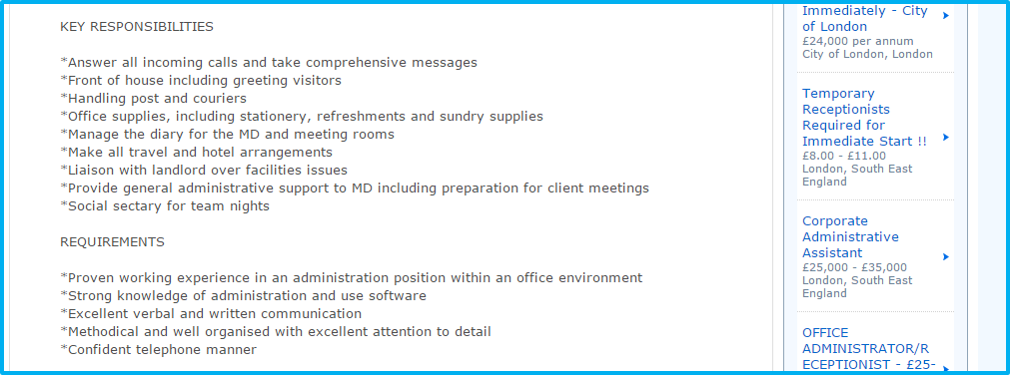
Go through as many adverts as you can and gather us much information about your target employers as you can.
What experience do they need? What skills do they need? What level of education do they prefer? What IT packages do they use? What will be expected of you in the role?As you go through the postings, make a list of the things that repeatedly appear… they will be the most sought after requirements.
After going through a few job Admin Assistant job adverts I have made a list of the things that most of the advertisers were looking for here.
Obviously your list may be very different depending on your industry but this should give you an idea of the types of things you should be writing down.
So before you start writing your CV, make your very own list just like this one.
Once you have your list of requirements that your target employers are looking for in applicants, then you have a huge advantage over most other candidates in the job market – because now you know exactly what you need to put in your CV to make it successful – you are not guessing like most other people who simply write a CV, send it out and hope for the best.
Some of the requirements in your list will be easy for you to include in your CV – especially the things that you already have a lot of experience in.
However some things may be a bit trickier – particularly when the adverts are asking for things that you have little or no experience of.
But this is OK – you just have to be a bit more creative – often you will find that you have a lot of transferable skills that you can draw from your experiences in and outside of work such as education projects, freelance work, volunteering etc.
I will cover this in more detail when we start writing your CV, but first we need to understand a little bit more about the people who will be reading your CV… Recruiters and Hiring Managers.
In order to land your next job – you are going to need to impress two types of people; hiring managers andrecruiters… there’s no way around that fact.
If you want to make a really good impression on them, then let’s try to look at things from their perspective – it will really help you get the best results from your CV and your overall job hunt.
So who are hiring managers and recruiters?
You may already have a rough idea but let’s dig a bit deeper to see what really makes them tick – and most importantly, how we can use what we know about them to create a CV that will make them stand up and pay attention to you.
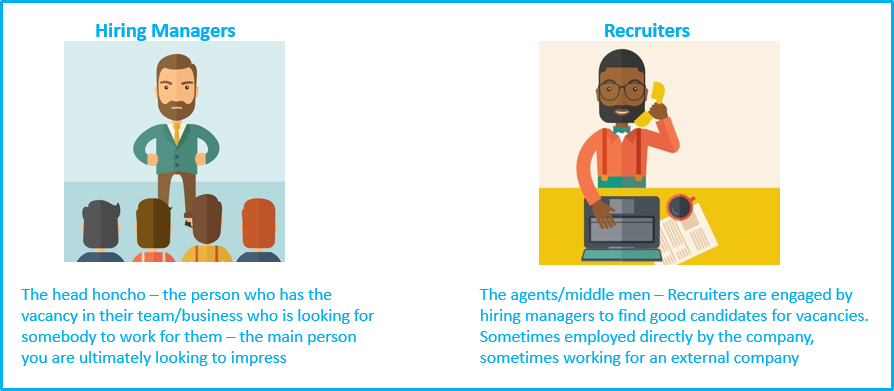
Having worked as a recruiter for several years and dealt with lots of hiring managers in my career, I can share 3 things about them both that will help you to write a CV that appeals to both of them.
1. They are both extremely busy with little time to spare

Recruiters and hiring managers have packed days; both working to constant deadlines with a million and one tasks to complete.
For this reason, they don’t like wasting time.
How does this help you?
If you want to impress them, make sure your CV takes up as little of their time as possible.
You need to ensure that your CV is short, sharp and gets your message across quickly.
I will show you how to do this in the following chapters, but for now you just need to know that this is a very important factor in the recruitment process.
2. They have lots of people competing for their attention

As a recruiter my inbox would sometimes have over 100 unread emails in it and I know that hiring managers are swamped with important calls and emails throughout the working week.
So if you get their attention, you need to make it count.
How does this help you?
Once you get a recruiter or hiring manager to open your CV, you need to make sure you hold their attention by making an instant impact.
So how do you do this?
By making the top part of your CV extremely relevant to them.
Again, I will cover how to do this this in more detail in the format, structure and content sections of this guide, but for now you just need to understand importance of making an instant impact with your CV.
I can tell you from personal experience that if a recruiter does not see what they need to see as soon they open your CV, then they will usually close it down and move straight on to the next CV – so you need to make sure your CV can hold people’s attention if you want to see the interviews roll in.
3. They scare easily

Recruiters and hiring managers have a reputations to maintain with their peers and clients – there’s a lot of pressure on them to make the right decisions… Especially when it comes to hiring staff.
If a hiring manager hires a bad candidate, it can literally ruin their business.
There is a lot at stake when it comes to hiring people.
How does this help you?
When writing your CV, you need to make sure that you don’t give anybody a single reason to doubt you. In a recent survey of recruitment firms that we ran at StandOut CV; we found that it only takes one grammar mistakefor a recruiter to start seriously doubting your credibility.
So when writing your CV, you need to ensure that your language is flawless and persuasive, the formatting and structure is perfect and you have a proper process in place to run final checks before getting the CV out to market.
Again, I will cover how you actually do this in greater detail during the following chapters.
OK, now you already have a huge advantage over most other candidates.
You know what your target employers want to see and you know a bit about the people who will be reviewing your CV.
So in summary, if your CV is going to win interviews it needs to do the 2 following things.
If you can do both of these things, you will land a lot of job interviews.
If you quickly show a recruiter or hiring manager that you have the skills needed for their job. They will look at the CV and instantly say, “This person can do the job, let’s get them in for an interview”.
So over the next few chapters I will explain exactly how you can do this with a structure that highlights the important information and content that will have your desired employers desperate to interview you.
Now that you know what to include in your CV and who will be reading it, you need to format and structure your CV in a way that will do the following things;
The infographic below gives a high level of overview of the best way to structure your CV.
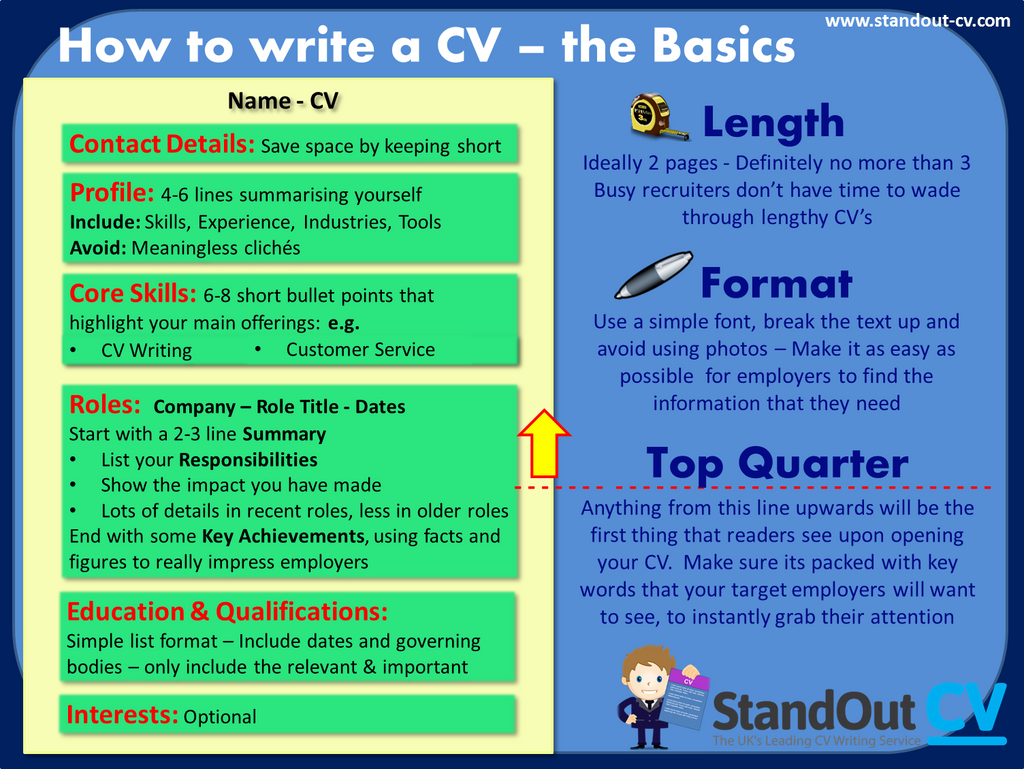
I’ll run through each section to give a bit more detail on each
As I mentioned earlier, recruiters and hiring managers tend to be very busy, so it’s best to keep your CV short and sharp to ensure it gets read.
Ideally your CV should be around 2 pages in length, but if you go a little over or under, don’t worry – there is noset-in-stone rule about around how long your CV should be.
If you have lots of experience then you may find that you stray on to the third page slightly, and conversely if you don’t have much experience, then you may struggle to fill the second page completely. Just to try to keep as close to 2 pages as you can.
Quick tip: If you find your CV is coming in too long – cut down some of the detail in your older roles as recruiters will be focusing more on your recent roles.
When formatting your CV, simplicity and readability are essential if you want to keep your CV readers happy.
Microsoft Word is the most widely used and liked format for CVs across the UK, so always send your CV in Word if you want to ensure it gets opened. Avoid sending your CV in PDF because it is non-editable and sometimes recruiters will need to make slight edits to your CV before they can send it on to hiring managers and clients.

The font you use just needs to be easy to read, professional looking and used consistently throughout the CV. At StandOut CV we use fonts like Arial, Tahoma and Calibri in our customer CVs. Avoid using overly complex fonts as they can be difficult to read and may discourage recruiters from reading your CV in full.

Unless you’re applying for an acting or modelling job, a photograph is not necessary in your CV. Photos take up a lot of the limited space available on your CV and it’s better to fill that space with compelling reasons for an employer to hire you.
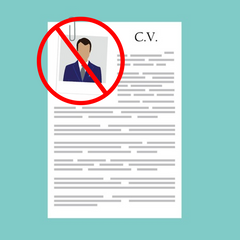
To keep your CV looking professional, it’s best to stick to black text on a white background for the body of your sections. It’s OK to add a splash of color to headings when applying to modern trendy firms (like tech startups for example) but don’t go crazy and ensure it still looks professional.
This an example of a typical that CV structure we have livened up with a bit of color.

Before I delve into the nuts and bolts of each CV section, here is a brief overview of the way your CV should be divided and sub-headed. The images also show how much space each section should take up on a typical 2 page CV.
Start the top of your CV with your name and contact details so that the reader knows who you are and how they can reach you if they want to invite you in for an interview.
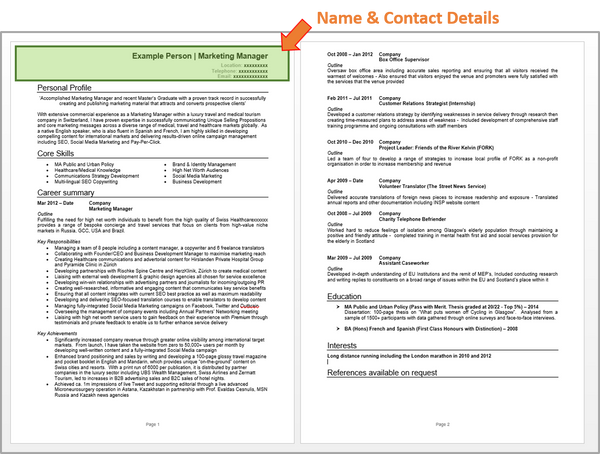
You can also add your LinkedIn profile address and even Twitter handle if you have a work-based Twitter profile.
Your CV profile is like an introduction that sits just under your contact details. The aim of your profile is to draw the reader in by summarising all of your skills and knowledge in a few punchy sentences that leaves them wanting to read more.
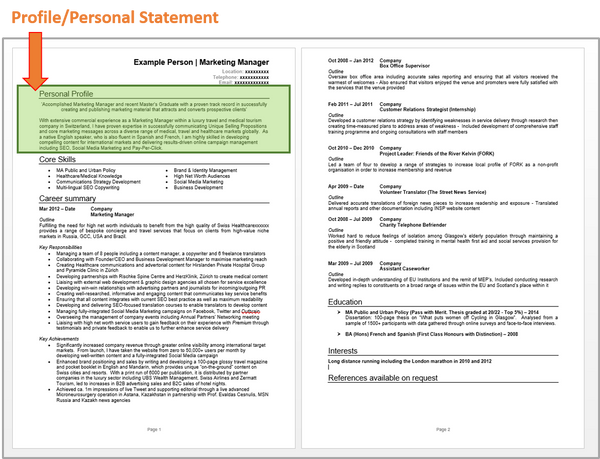
After your profile, you need to detail your current and previous employment to showcase the work that you’ve done and how you’ve helped your employers. Generally your roles should be listed in reverse chronological order (from most recent to oldest) but there are some occasions where you can make exceptions to that rule.
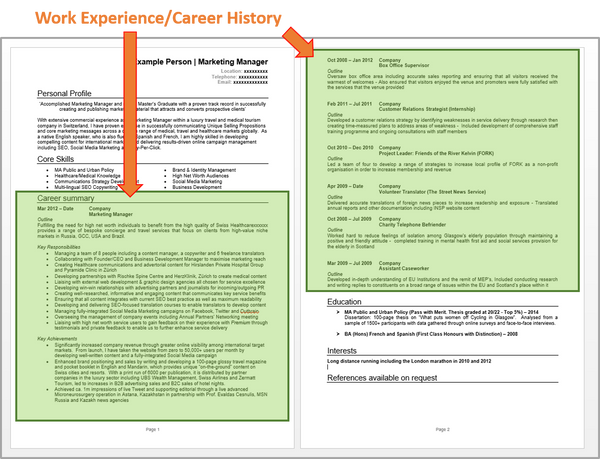
Near the bottom of your CV you should list your education and qualifications. Generally speaking school leavers and recent graduates should include a lot of detail here to make up for the lack of work experience – whereas experienced candidates can afford to have a shorter education section, as their role descriptions will be more important to recruiters.

Interests are an optional section and should only really be included where they can add value to an application e.g. work related interests, volunteering, impressive achievements etc.

Now I will run through how to structure and write all of these sections;
Your Profile (or Personal Statement as it is often referred to in academic fields) is the very first thing a recruiter or hiring manager will read, so you need to ensure that it is packed with the requirements that your target employers are looking for.
Here are a couple of example CV profiles to give you an idea of how they should look and read.


Sitting at the top of your CV, the purpose of your profile is to give a rounded summary of your talents and show what you have to offer an employer, in a few punchy yet professional sentences.
Focus on including hard factual skills such as industry specific skills, experience, languages, software knowledge etc.
And really try to avoid using CV clichés and buzzwords.
What are clichés and buzzwords?
Clichés and buzzwords are vague phrases that are often used to describe “soft skills” such as:
You’ve probably seen them and you may have even been tempted to use them in your CV.
The problem with clichés and buzzwords is that they tend to be very generic and don’t tell the reader much about you in reality, so it’s best to keep them out of your CV or at least keep them to a minimum.
If you want to prove you’re a hard-working team-player, then give examples of team based results you’ve achieved in your role descriptions.
This way the reader can see relevant examples of how you apply your skills in your work rather than just being told that you are a “hard worker”.
Here is an example of a bad profile section. Read it and see if you can tell what the candidate actually does…
“Hard working professional who works well in a team or individually, quick to grasp new ideas & skills. I take pride in my work and strive for excellence and always meet deadlines”
What job would this person be suitable for?
Although it may sound impressive, it’s impossible to tell what this candidate has to offer because the profile is full of clichés and contains no facts – this is what you should avoid at all costs.
Some of the points may be important but they are totally meaningless without facts and context so recruiters won’t learn anything about you with a profile like this.
Here is how we re-wrote this section of the candidate’s profile…
“Accomplished Project Support Assistant with a proven track record in the support of large construction teams on the delivery of complex housing builds within strict budgets and deadlines”
If you make your profile more factual like this, it will give recruiters a greater understanding of what you have to offer.
A core skills section is a very simple but effective section you can add to the bottom of your profile.
It’s essentially a bullet pointed list of attributes which ideally should relate directly to the requirements that your employers are looking for.
Here is an example from a candidate applying for a customer service role in retail banking.

The effect is that each point jumps out of the page at the reader and shows them that you are a good fit for the role, just from glancing at your CV. This helps you to create that big instant impression that you need to get a response from your job applications.
You can include anything that will be relevant from IT skills and industry knowledge, to education results and achievements. Just make sure they are important to the roles you are applying for by checking with relevant job adverts.

Your work experience gives you an excellent opportunity to showcase your abilities and really delve into the details of what you can offer an employer.
Your role descriptions need to convey that your experience equips you with the skills and knowledge needed to carry out the jobs you are applying for.
First I will give you an overview of which roles to include and how to list them – then I will demonstrate how to structure each role for maximum effect.
Roles should be written in reverse chronological order starting with your current or most recent role and working your way down to your oldest role.
This generally works very well for those with experience in the field they are applying to – but candidates with limited experience or those making a career change can break this rule slightly if they need to (I will cover this more in the next section).
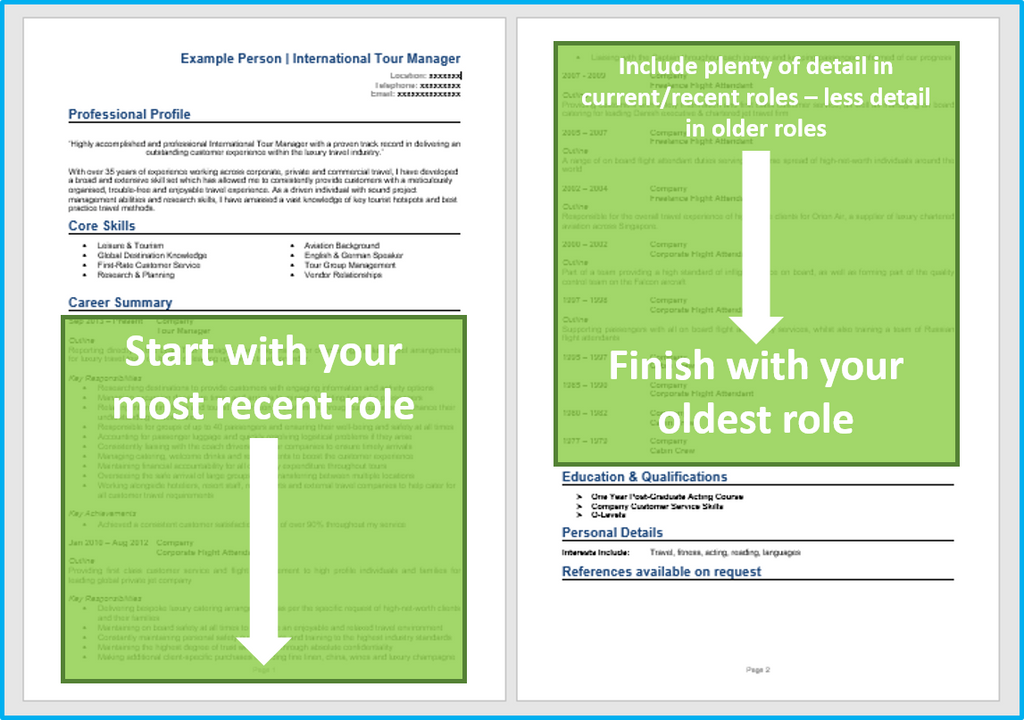
You will mainly want to include your paid jobs but you can also add voluntary positions or even university/college work placements if they are relevant to the roles you are applying to.
Your current role and recent roles should contain lots of detail because recruiters are most interested in what you are capable of right now.
Older roles can be summarised as you go down the CV, as recruiters will be less interested in your roles from several years ago.
If you’ve got plenty of experience in the field you are applying to – you may want to skip this section. Click here to skip
You don’t always have to start your CV roles with your most recent paid role – especially if you fall in to one of the 2 following categories.


If you fall into one of these brackets then it’s likely that your most recent paid role will not be entirely relevant to the firms you are applying for.
If your most recent role won’t appeal to your target employers, then you can use a bit of creative licence and insert a more relevant past role at the top of your CV such as:
Let’s take a look at the example candidates above and see how they can break the chronological order role slightly, to make their CVs appear more suitable for the jobs they are applying to.
1. Recent graduate or school leaver
If you are a recent graduate or school leaver, you can often use older work placements and other non-paid roles to replace your current role at the top of your CV, if it makes your CV appear more relevant.
Take a look at the example below
Laura has recently graduated with a degree in aerospace engineering and is looking for an entry level job with an aerospace design firm.
Laura’s current job as a waitress in a local restaurant is not hugely relevant to the aerospace firms she is applying to, so she shouldn’t put the waitress role at the top of her CV if she can avoid it.
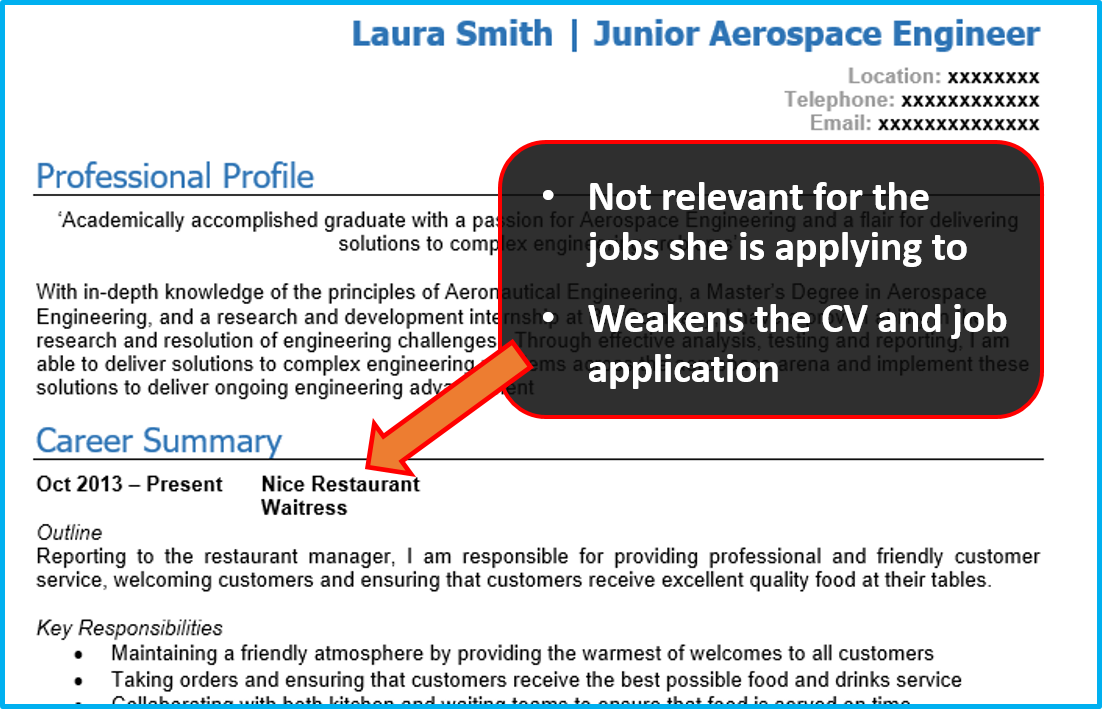
However, Laura did complete a one month work placement for an aerospace research firm in 2012 as part of her University degree.
In this case, Laura should list the aerospace work placement at the top of her work experience section – she shouldn’t keep it hidden in her education section at the bottom of her CV.
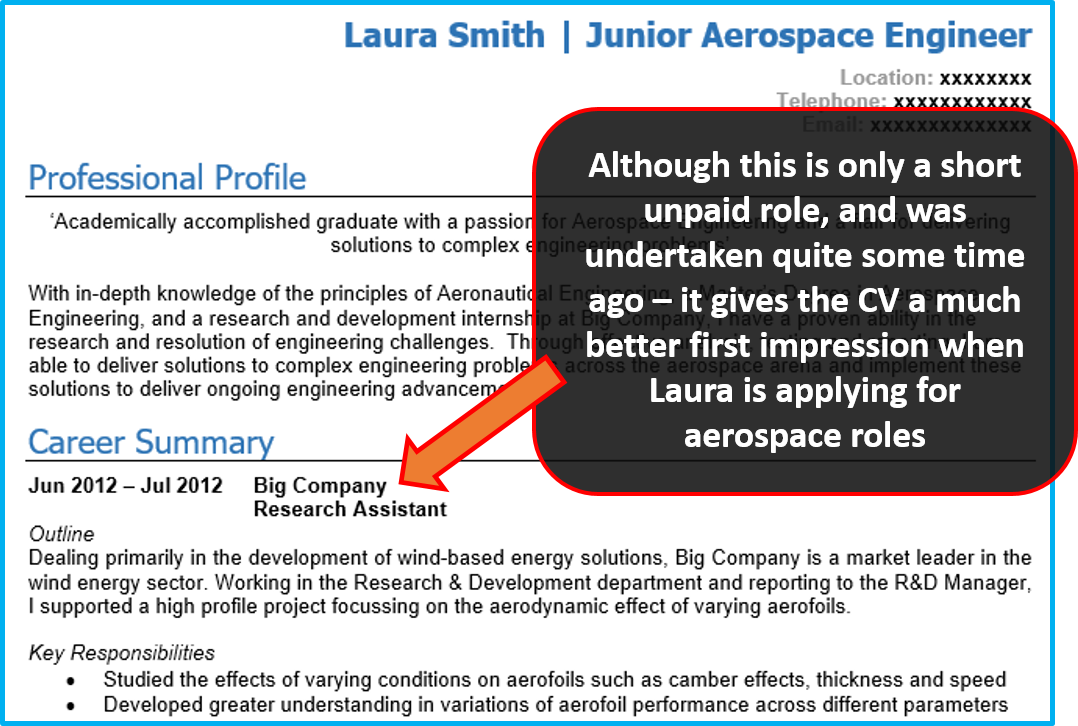
Now recruiters will instantly be able to see that Laura has relevant work experience as soon as they open her CV and she will seem much more suitable for the role.
Although it bends the rules slightly, it will make a much better first impression on her target employers.
2. Somebody looking to make a career change
Also if you’re looking to make a career change then your current role will probably not be relevant to the roles you are applying for.
For example David has got lots of experience in IT support, which is great – but now that he is looking to move into a care worker position, his current IT support manager role will not be relevant to the employers he is hoping to impress.
David has however done a few weeks of voluntary care work at a local nursing home a few months ago.
In this case David just needs to slot the voluntary care role above his current IT role to instantly show recruiters that he has some relevant experience.

Being creative with your first listed role in this manner does technically bend the CV writing rules slightly, but it gives you a much greater chance of impressing employers and landing interviews.
If you don’t have any experience at all that you can add in this fashion, then the simple solution is to go out and get some. Look for voluntary work, sign up to freelancing websites, take a training course or even offer to help businesses for free. Even if you only get a few weeks experience, it can be a huge boost to your CV, so it’s worth doing.
If you want your role descriptions to be easily readable and really highlight the value in hiring you, then they need to be well structured and written.
The annotated example here shows how to structure your roles for maximum results.
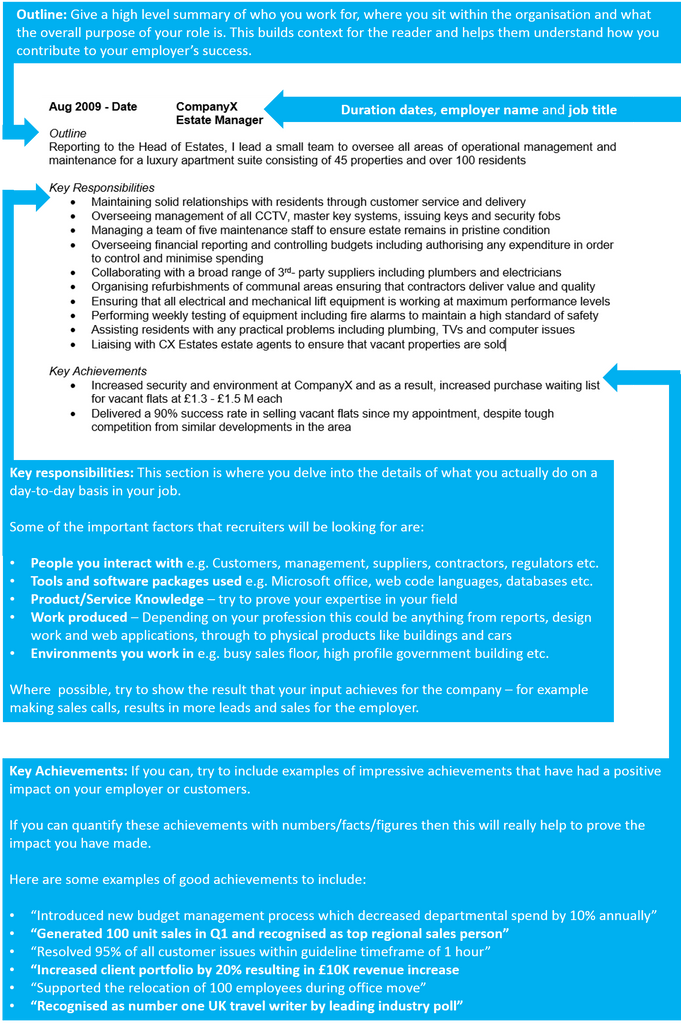
As with your entire CV, you should try to highlight the skills and experience that your audience will be looking for.
Prioritise the responsibilities by ensuring that the most relevant information for your target employers is at the top of each role in great detail.

Long periods of unemployment can be off-putting for employers because it simply appears as though you haven’t been doing anything during that period – unless you state otherwise.
So if you have any periods of unemployment that lasted over a month or so, then try to fill them with constructive activities to make yourself look pro-active and positive e.g.
If you’ve had time out for personal reasons such as a serious illness, then don’t be worried about including it on your CV – employers should not discriminate against you for it. Just keep the detail light and focus on highlighting your value throughout the rest of your CV.
The language used in your CV should be professional, persuasive, descriptive and grammatically perfect throughout.
It should read like a sales brochure for a luxury product; leaving the reader desperate to call you, just in case they miss out on the opportunity.
The language used in your CV gives recruiters an insight into your written communication skills and your professionalism, so make it count.
Avoid using basic language because it makes you look like a basic candidate, when you need to look outstanding.
By basic language, I mean writing in a plain and non-descriptive fashion like this…
“I was working for the manager and helping out with various tasks across the business”
That looks dull, uninspiring and a not too impressive
However you can reword the exact same responsibilities to be more descriptive and sound much more impressive, like this:
“Reporting directly to the manager, supporting a number of business critical functions”
Even something like;
“Stacking shelves”
Can be improved to something like;
“Managing and analysing stock levels throughout the store to ensure that customers always have access to high demand products at peak times”
Although that’s an extreme example, it displays a better style of written communication and shows that you have an understanding of how the task affects the business at a higher level.
When writing your CV, ensure that you are using professional language at all times and fully describing your impact on employers.
If you find yourself struggling to write professionally, head over to LinkedIn and run a search for similar professionals to yourself. Browse through a few profiles and look at the language being used for some inspiration.

Although you can mention your education and qualifications in your CV profile, their full details should be listed near to the bottom of your CV. The amount of information that you include in this section will largely depend on your experience level.
Generally speaking, if you have lots of work experience, you won’t need to write about your education in great detail, as recruiters will be more interested in your work history.
If you are relatively inexperienced, such as recent graduate or school leaver, then you should write about your education in more detail because that’s where most of your skills and experience will lie.
To counter your lack of work experience, you can include dissertations, school/university projects, exam modules etc. and endeavour to highlight the points that are relevant to the roles you are applying to.
The following examples show how to list your education at different stages in your career.
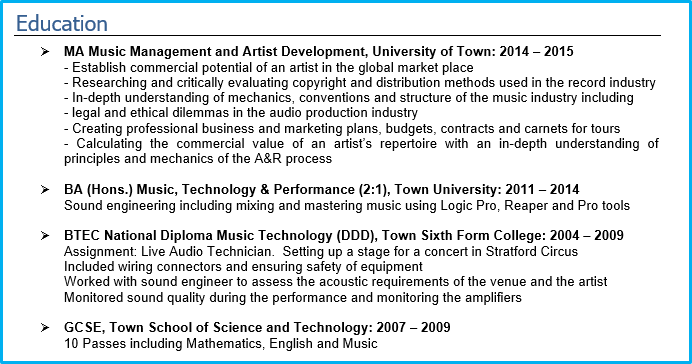

Candidates often ask whether or not they need to include their interests on their CV and if they will actually make a difference in an application.
The answer depends on two aspects – the role that you are applying for and if your interests bear any relevance to the role.
On one hand, if you are an experienced and qualified doctor applying for a GP role, then adding your interests ofgoing to the cinema or watching football will have little impact on your application – they just don’t add any value.
However if you are a recent graduate applying for a management Grad scheme with little work experience, then a hobby such as captaining a football team, can actually be a great way to demonstrate leadership and organisation.
Interests are optional and in many cases they won’t make a huge difference – but if you feel that they could impact your application then you should include them.
Sports teams or interest societies and clubs – competing in sports or other pursuits can show determination, team work and a competitive nature.
Travel – travelling can be of interest to employers as it can show independence, organisation and an outgoing personality.
Volunteering – volunteering for charities or community projects shows pro-activity and a willingness to help others, which are both desirable traits in an employee.
“Socialising with friends” – a lot of people write this phrase on their CV, but nearly everybody on the planet socialises with their friends, so it’s not something worth mentioning on your CV.
Political/Religious views – politics and religion are probably a bit heavy for a CV and won’t really add much to the strength of an application.
Anything that could be considered controversial or slightly weird – if you are into witchcraft or hamster grooming then that’s fine… but best not to add it to your CV to avoid being pre-judged by recruiters.
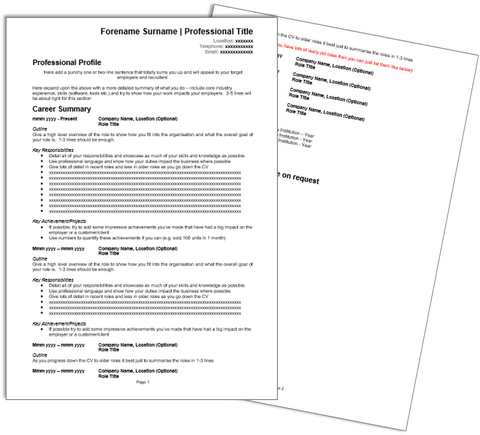
Download our basic Microsoft Word CV template here to get a head start with your own CV. Using the CV template in conjunction with this guide should put you on the right track to creating an impressive CV and kick starting your job hunt.

Once you’ve finished writing your CV then make sure that you triple check it for errors before sending it out to anybody.
Nothing will put a recruiter off you more quickly than spelling errors, typos and grammatical mistakes.
Perhaps even ask a friend or family member to run through it to get a different perspective and ensure it all makes sense.
Also ensure that the CV sits at around 2 pages in length and that all the information is nicely broken up for ease of reading.
Now you are ready to start job hunting.
Once you’ve started your job hunt, you can still make changes to your CV if you need to.
For example you may want to tailor your CV when applying for different roles to further ensure that your CV matches each job advert.
You may find that certain areas of your CV are prompting negative feedback and will need to be modified in order to improve your chances.
Any adaptions you can make that lead to more interview requests, are worth making.
Hopefully this guide will help you to create your own CV and start to land quality job interviews in your chosen field.
Happy Job Hunting!